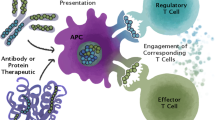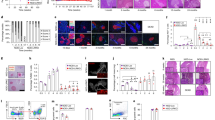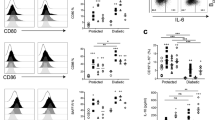Abstract
Type 1 diabetes (T1D), a T-cell-mediated autoimmune disease, could be attributed to many defects in nonobese diabetic (NOD) mice, including deficient expressions of costimulatory molecules that impair antigen presentation. Thus, this deficient antigen presentation may result in a reduced ability to induce a tolerogenic response through negative selection/regulation of autoreactive T cells. Improperly activated T cells seem to be able to induce autoimmune responses causing diabetes. To re-establish tolerance to autoantigens by modulating costimulation, we constructed and tested a new type of DNA vaccine encoding a membrane-bound preproinsulin (mbPPI) and a chimeric gene vector encoding mutant B7.1/CD40L (mB7.1/CD40L) fusion protein. This mutant B7.1 binds CTLA4 but not CD28. We report that young NOD mice immunized with mbPPI along with mB7.1/CD40L DNA vectors significantly reduced diabetes incidence while treatment with CTLA4/IgG1 exacerbated diabetes. In conclusion, the combination of mbPPI and mB7.1/CD40L was able to protect against autoimmunity and diabetes in NOD mice possibly by promoting a more efficient presentation of autoantigen PPI and inducing specific tolerance to PPI by negatively regulating autoreactive T cells.
This is a preview of subscription content, access via your institution
Access options
Subscribe to this journal
Receive 12 print issues and online access
$259.00 per year
only $21.58 per issue
Buy this article
- Purchase on Springer Link
- Instant access to full article PDF
Prices may be subject to local taxes which are calculated during checkout








Similar content being viewed by others
References
Adorini L, Gregori S, Harrison LC . Understanding autoimmune diabetes: insights from mouse models. Trends Mol Med 2002; 8: 31–38.
Serreze DV, Leiter EH . Genes and cellular requirements for autoimmune diabetes susceptibility in nonobese diabetic mice. Curr Dir Autoimmun 2001; 4: 31–67.
Suarez-Pinzon WL, Rabinovitch A . Approaches to type 1 diabetes prevention by intervention in cytokine immunoregulatory circuits. Int J Exp Diabetes Res 2001; 2: 3–17.
Gottlieb PA, Hayward AR . Cytokine and immunosuppressive therapies of type 1 diabetes mellitus. Endocrinol Metab Clin North Am 2002; 31: 477–495.
Rudy G et al. Similar peptides from two beta cell autoantigens, proinsulin and glutamic acid decarboxylase, stimulate T cells of individuals at risk for insulin-dependent diabetes. Mol Med 1995; 1: 625–633.
French MB et al. Transgenic expression of mouse proinsulin II prevents diabetes in nonobese diabetic mice (published erratum appears in Diabetes 1997 May 46:924). Diabetes 1997; 46: 34–39.
Chen W et al. Evidence that a peptide spanning the B–C junction of Proinsulin is an early autoantigen epitope in the pathogenesis of type 1 diabetes. J Immunol 2001; 167: 4926–4935.
Ivana D-B, Bernhard OB, Ziegler A-G . Predominantly recognized proinsulin T helper cell epitopes in individuals with and without islet cell autoimmunity. J Autoimmun 2002; 18: 55–66.
Dubois-Lafforgue D et al. Proinsulin 2 knockout NOD mice: a model for genetic variation of insulin gene expression in type 1 diabetes. Diabetes 2002; 51 (Suppl 3): S489–S499.
Thebault-Baumont K et al. Acceleration of type 1 diabetes mellitus in proinsulin 2-deficient NOD mice. J Clin Invest 2003; 111: 851–857.
Dahlen E, Hedlund G, Dawe K . Low CD86 expression in the nonobese diabetic mouse results in the impairment of both T cell activation and CTLA-4 up-regulation. J Immunol 2000; 164: 2444–2456.
Strid J et al. A defect in bone marrow derived dendritic cell maturation in the nonobesediabetic mouse. Clin Exp Immunol 2001; 123: 375–381.
Piganelli JD, Martin T, Haskins K . Splenic macrophages from the NOD mouse are defective in the ability to present antigen. Diabetes 1998; 47: 1212–1218.
Rapoport MJ et al. Thymic T cell anergy in autoimmune nonobese diabetic mice is mediated by deficient T cell receptor regulation of thr pathway of p21 ras activation. J Exp Med 1993; 177: 1221–1226.
Serreze DV . Autoimmune diabetes results from genetic defects manifest by antigen presenting cells. FASEB J 1993; 7: 1092–1096.
Salojin K et al. Impaired plasma membrane targeting of Grb2-murine son of sevenless (mSOS) complex and differential activation of the Fyn-T cell receptor (TCR)-ζ-Cb1 pathway mediate T cell hyporesponsiveness in autoimmune nonobese diabetic mice. J Exp Med 1997; 186: 887–897.
Serreze DV, Gaskins HR, Leiter EH . Defects in the differentiation and function of antigen presenting cells in NOD/Lt mice. J Immunol 1993; 150: 2534–2543.
Piganelli JD et al. Cytotoxic T lymphocyte antigen 4 (CD152) regulates self-reactive T cells in BALB/c but not in the autoimmune NOD mouse. J Autoimmun 2000; 14: 123–131.
Lenschow DJ et al. CD28/B7 regulation of Th1 and Th2 subsets in the development of autoimmune diabetes. Immunity 1996; 5: 285–293.
Arreaza GA et al. Neonatal activation of CD28 signaling overcomes T cell anergy and prevents autoimmune diabetes by an IL-4-dependent mechanism. J Clin Invest 1997; 100: 2243–2253.
Lenschow DJ et al. Differential effects of anti-B7-1 and anti-B7-2 monoclonal antibody treatment on the development of diabetes in the nonobese diabetic mouse. J Exp Med 1995; 181: 1145–1155.
Ueda H et al. Association of the T-cell regulatory gene CTLA4 with susceptibility to autoimmune disease. Nature 2003; 423: 506–511.
Prud'homme GJ . Gene therapy of autoimmune diseases with vectors encoding regulatory cytokines or inflammatory cytokine inhibitors. J Gene Med 2000; 2: 222–232.
Garren H, Steinman L . DNA vaccination in the treatment of autoimmune diseases. Curr Dir Autoimmun 2000; 2: 203–216.
Scheerlinck JY . Genetic adjuvants for DNA vaccines. Vaccine 2001; 19: 2647–2656.
Prud'homme GJ, Chang Y, Li X . Immunoinhibitory DNA vaccine protects against autoimmune diabetes through cDNA encoding a selective CTLA-4 (CD152) ligand. Human Gene Ther 2002; 13: 395–406.
Polanski M, Melican NS, Zhang J, Weiner HL . Oral administration of the immunodominant B-chain of insulin reduces diabetes in a co-transfer modes of diabetes in the NOD mouse and is associated with a switch from Th1 to Th2 cytokines. J Autoimmun 1997; 10: 339–346.
Harrison LC, Dempsey-Collier M, Kramer DR, Takihashi K . Aerosol insulin induces regulatory CD8 gamma/delta T cells that prevent murine insulin-dependent diabetes. J Exp Med 1996; 184: 2167–2174.
Ramiya VK, Shang XZ, Wasserfall CH, Maclaren NK . Effect of oral and intravenous insulin and glutamic acid decarboxylase in NOD mice. Autoimmunity 1997; 26: 139–151.
Hutchings P, Cooke A . Comparative study of the protective effect afforded by intravenous administration of bovine or ovine insulin to young NOD mice. Diabetes 1995; 44: 906–910.
Daniel D, Wegmann DR . Protection of nonobese diabetic mice from diabetes by intranasal or subcutaneous administration of insulin B-(9-23). Proc Natl Acad Sci USA 1996; 93: 956–960.
Chen W et al. Evidence that a peptide spanning the B–C junction of proinsulin I is an early autoantigen epitope in the pathogenesis of type 1 diabetes. J Immunol 2001; 167: 4926–4935.
Martinez NR et al. Disabling an integral CTL epitope allows suppression of autoimmune diabetes by intranasal proinsulin peptide. J Clin Invest 2003; 111: 1365–1371.
Halbout P et al. T cell response to preproinsulin I and II in the nonobese diabetic mouse. J Immunol 2002; 169: 2436–2443.
Urbanek-Ruiz I et al. Immunization with DNA encoding an immunodominant peptide of insulin prevents diabetes in NOD mice. Clin Immunol 2001; 100: 164–171.
Bot A et al. Plasmid vaccination with insulin B chain prevents autoimmune diabetes in nonobese diabetic mice. J Immunol 2001; 167: 2950–2955.
Weaver Jr DJ, Liu B, Tisch R . Plasmid DNAs encoding insulin and glutamic acid decarboxylase 65 have distinct effects on the progression of autoimmune diabetes in nonobese diabetic mice. J Immunol 2001; 167: 586–592.
Karges W et al. Induction of autoimmune diabetes through insulin (but not GAD65) DNA vaccination in nonobese diabetic and in RIP-B7.1 mice. Diabetes 2002; 51: 3237–3244.
van Essen D, Kikutani H, Gray D . CD40 ligand-transduced co-stimulation of T cells in the development of helper function. Nature 1995; 378: 620–623.
Goodnow CC . Pathways for self-tolerance and treatment of autoimmune diseases. The Lancet 2001; 357: 2115–2121.
Lederman S . The role of CD154 (CD40-ligand) in costimulation. Transplantation Proceedings 2001; 33: 202–206.
Williams JA, Sharrow SO, Adams AJ, Hodes RJ . CD40 ligand functions non-cell autonomously to promote deletion of self-reactive thymocytes. J Immunol 2002; 168: 2759–2765.
Li R, Page DM . Requirement for a complex array of costimulators in the negative selection of autoreactive thymocytes in vivo. J Immunol 2001; 166: 6050–6056.
Tian J et al. Lipopolysaccharide-activated B cells down-regulate Th1 immunity and prevent autoimmune diabetes in nonobese diabetic mice. J Immunol 2001; 167: 1081–1089.
Steptoe RJ, Ritchie JM, Harrison LC . Transfer of hematopoietic stem cells encoding autoantigen prevents autoimmune diabetes. J Clin Invest 2003; 111: 1357–1363.
Prud'homme GJ, Chang Y . Prevention of autoimmune diabetes by intramuscular gene therapy with a nonviral vector encoding an interferon-γ receptor/IgG1 fusion protein. Gene Therapy 1999; 6: 771–777.
Chang Y, Prud'homme GJ . Intramuscular administration of expression plasmids encoding interferon-gamma-receptor/IgG1 or IL-4/IgG1 chimeric proteins protects from autoimmunity. J Gene Med 1999; 1: 415–423.
Guo Y, Wu Y, Kong X, Liu Y . Identification of conserved amino acids in murine B7-1IgV domain critical for CTLA4/CD28:B7 interaction by site-directed mutagenesis: a novel structural model of the binding site. Mol Immunol 1998; 35: 215–225.
Guo Y et al. Mutational analysis of an alternatively spliced product of B7 defines its CD28/CTLA4-binding site on immunoglobulin C domain. J Exp Med 1995; 181: 1345–1355.
Lawson BR et al. Treatment of murine lupus with cDNA encoding IFN-gammaR/Fc. J Clin Invest 2000; 106: 207–215.
Acknowledgements
This study was supported by Research Advisory Committee of Children's Hospital of Pittsburgh and Juvenile Diabetes Research Foundation International.
Author information
Authors and Affiliations
Rights and permissions
About this article
Cite this article
Chang, Y., Yap, S., Ge, X. et al. DNA vaccination with an insulin construct and a chimeric protein binding to both CTLA4 and CD40 ameliorates type 1 diabetes in NOD mice. Gene Ther 12, 1679–1685 (2005). https://doi.org/10.1038/sj.gt.3302578
Received:
Accepted:
Published:
Issue Date:
DOI: https://doi.org/10.1038/sj.gt.3302578
Keywords
This article is cited by
-
Antigen-specific tolerance strategies for the prevention and treatment of autoimmune disease
Nature Reviews Immunology (2007)



